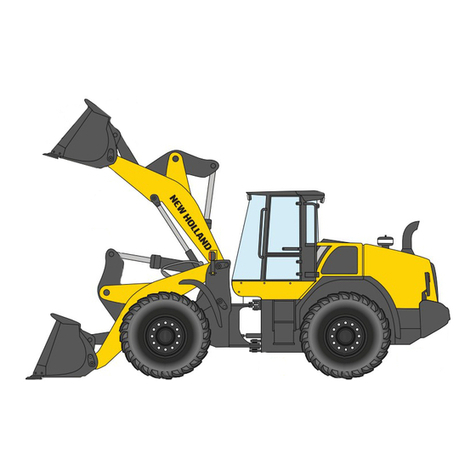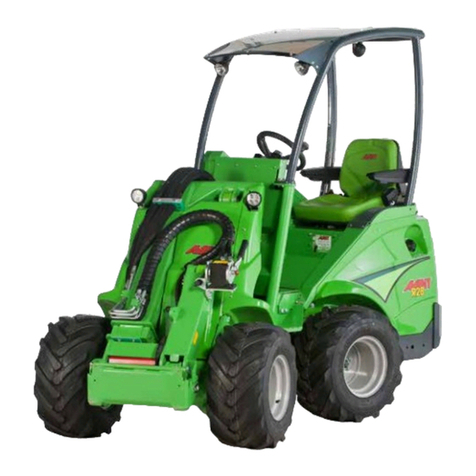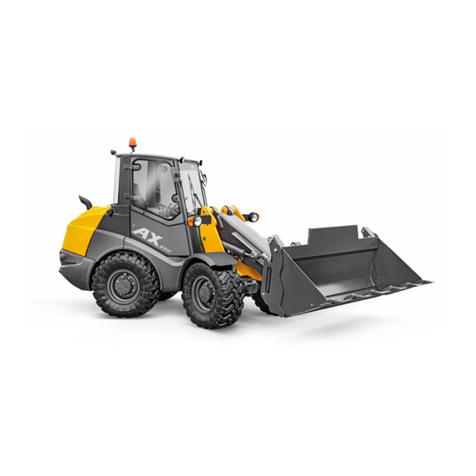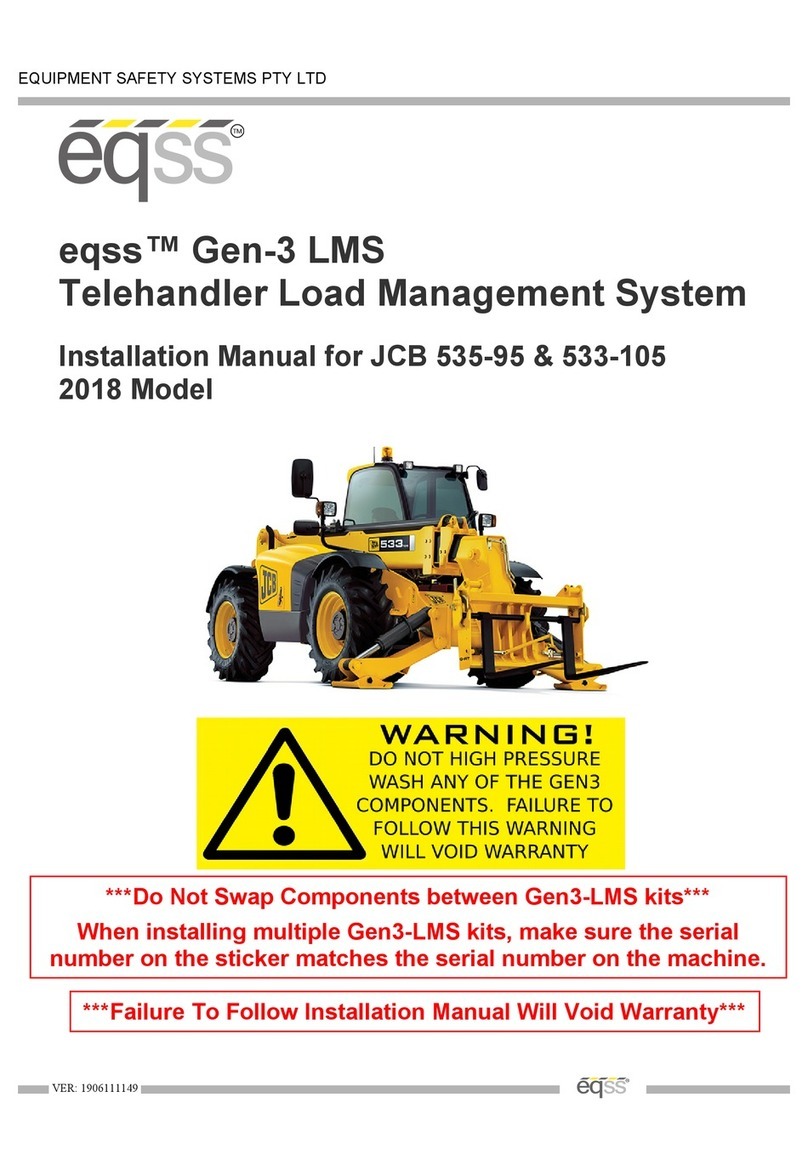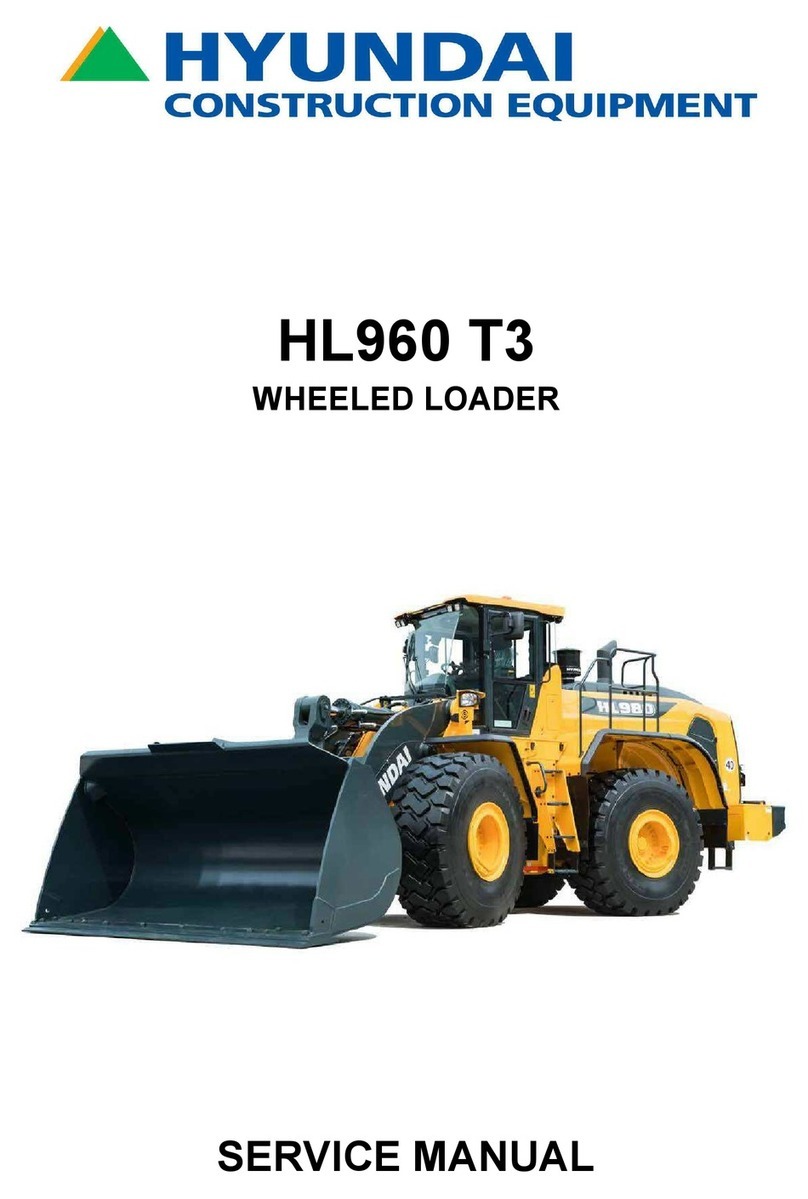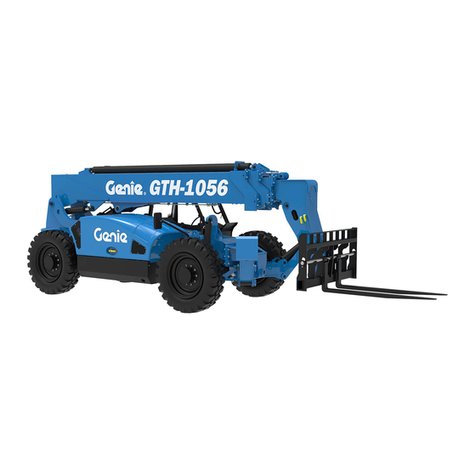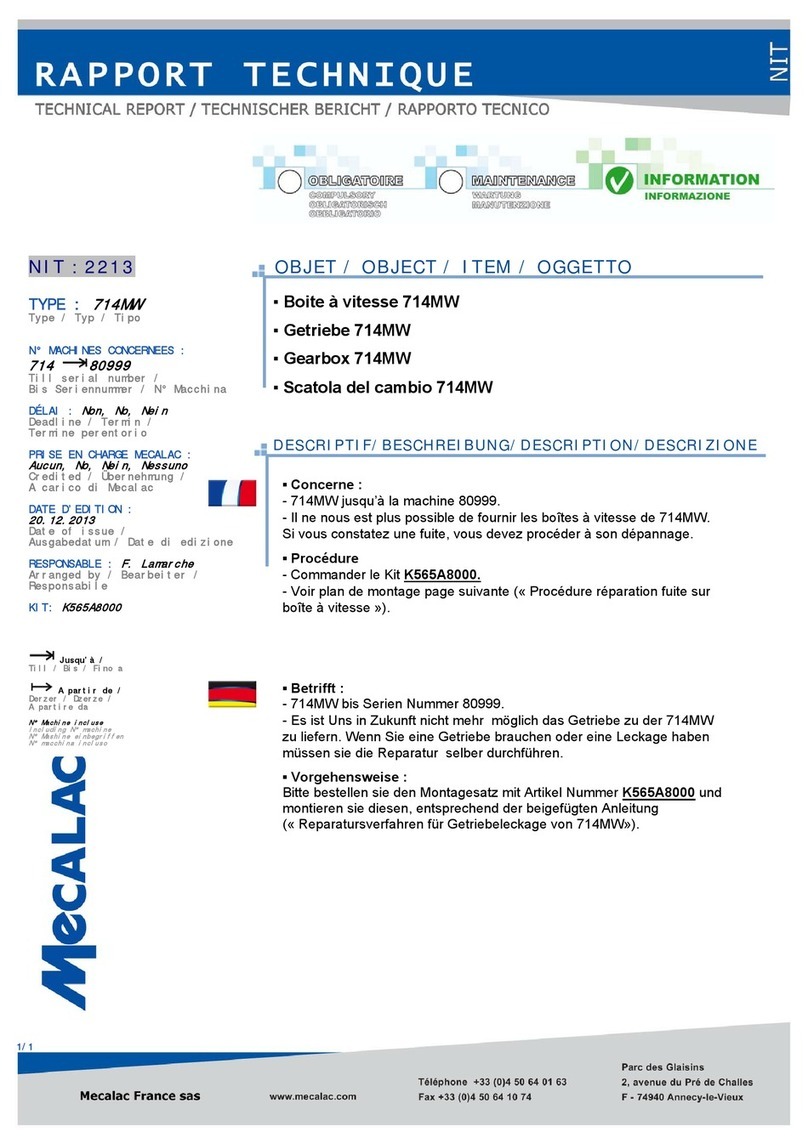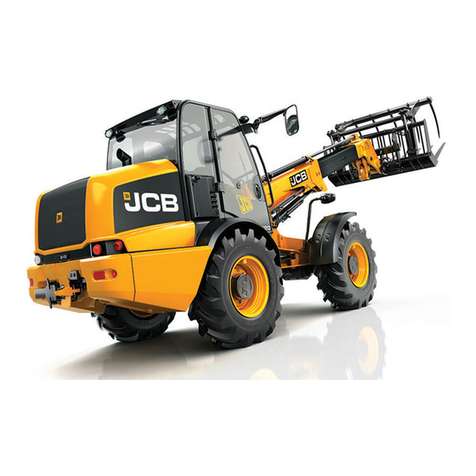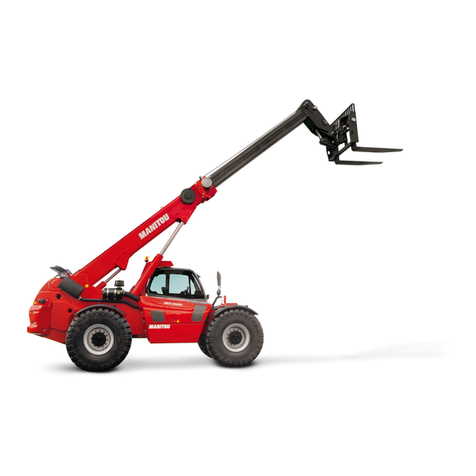Eurotrac W11 User manual

P. de Heus en Zonen Greup B.V.
Stougjesdijk 153
3271 KB Mijnsheerenland
The Netherlands
Tel: +31 (0) 18 66 12 333
E-mail: info@eurotrac.nl
W11/W12/W13 WHEEL LOADER
OPERATION MANUAL

CONTENTS
W11/W12/W13 | Operation manual
FOREWORD ......................................................................................................................................... 4
1. BASIC INFORMATION ................................................................................................................. 5
2. GENERAL SAFETY INSTRUCTIONS ................................................................................................ 6
2.1 Organizational measures...................................................................................................................... 6
2.2 Personnel selection and qualifications/fundamental duties................................................................ 7
2.3 Safety instructions for certain phases of operation ............................................................................. 7
2.3.1 Safety instructions for standard mode ................................................................................................ 7
2.3.2 Safety instructions for service mode ................................................................................................... 8
2.4 Safety instructions for special hazard types......................................................................................... 9
2.4.1 Transporting general cargo .................................................................................................................. 9
2.4.2 Electrical energy ................................................................................................................................ 10
2.4.3 Gas, dust, vapors, smoke ................................................................................................................... 10
2.4.4 Hydraulics, pneumatic system ........................................................................................................... 10
2.4.5 Noise .................................................................................................................................................. 10
2.4.6 Oils, greases and other chemical substances .................................................................................... 11
2.5 Transporting and towing/recommissioning ....................................................................................... 11
2.6 Final decommissioning/dismantling................................................................................................... 11
2.7 Safety decals used .............................................................................................................................. 11
2.8 Safety equipment ............................................................................................................................... 13
2.8.1 Fire extinguishers ............................................................................................................................... 13
2.8.2 Rotating warning beacon ................................................................................................................... 13
2.8.3 Lowering brake valves on lifting and tipping ram .............................................................................. 13
2.8.4 Reversing warning signal ................................................................................................................... 13
2.8.5 Battery isolator switch ....................................................................................................................... 14
2.8.6 Safety belt ..........................................................................................................................................14
3. OPERATION AND HANDLING .................................................................................................... 15
3.1 Before commissioning........................................................................................................................ 15
3.1.1 Fueling ...............................................................................................................................................15
3.1.2 Entering .............................................................................................................................................. 16
3.1.3 Adjusting the driver's seat ................................................................................................................. 17
3.1.4 Steering column adjustment (optional extra) .................................................................................... 17
3.1.5 Safety belt ..........................................................................................................................................17
3.2 Commissioning ................................................................................................................................... 18
3.2.1 Lighting system .................................................................................................................................. 18
3.2.2 Work spotlight (optional extra) ......................................................................................................... 19
3.2.3 Before starting the engine ................................................................................................................. 19
3.2.4 Starting the engine ............................................................................................................................ 19
3.3 Driving ................................................................................................................................................ 21
3.3.1 Preparing to drive on public highways .............................................................................................. 21
3.3.2 Driving ................................................................................................................................................ 21
3.3.3 Direction switch ................................................................................................................................. 22
3.3.4 Differential lock ................................................................................................................................. 22
3.3.5 Moving away with the wheel loader ................................................................................................. 23
3.3.6 Braking and stopping ......................................................................................................................... 24
3.3.7 Changing the direction of travel ........................................................................................................ 24
3.3.8 Stopping and parking ......................................................................................................................... 24
3.4 Work mode......................................................................................................................................... 25
3.4.1 Before starting work .......................................................................................................................... 25
3.4.2 Folding roll bar (optional extra) .........................................................................................................25
3.4.3 Joystick for lifting frame .................................................................................................................... 26
3.4.4 Joystick for ancillary hydraulics .........................................................................................................26

CONTENTS
W11/W12/W13 | Operation manual
3.4.5 Lifting frame locking and joystick for ancillary hydraulics ................................................................. 27
3.4.6 Replacing attachments ...................................................................................................................... 28
3.4.7 Front bucket ....................................................................................................................................... 31
3.4.8 Measures when the wheel loader tips over ...................................................................................... 34
3.4.9 Precautionary measures for different weather conditions ............................................................... 34
3.5 Optional extras................................................................................................................................... 36
4. TOWING AND TRANSPORTING ................................................................................................. 37
4.1 Towing................................................................................................................................................ 37
4.2 Transporting ....................................................................................................................................... 38
5. MEASURES IF THE ENERGY SUPPLY FAILS .................................................................................. 40
6. DISCHARGING RESIDUAL PRESSURE IN HYDRAULIC SYSTEM ..................................................... 41
7. SECURING THE WHEEL LOADER ................................................................................................ 42
8. DATA AND SPECIFICATIONS ......................................................................................................43
8.1 Displays on the instrument panel (cockpit)........................................................................................ 43
8.2 Specifications and performance (table) ............................................................................................. 44
8.3 Power at the pallet fork..................................................................................................................... 45
9. DIMENSIONS ............................................................................................................................ 46
10. SERVICING AND INSPECTION ....................................................................................................48
10.1 General safety instructions for servicing and inspection operating instructions............................... 48
10.2 Servicing and inspection intervals...................................................................................................... 51
10.3 Lubrication schedule .......................................................................................................................... 54
10.4 Cleaning the wheel loader.................................................................................................................. 55
10.5 General safety checks......................................................................................................................... 56
10.6 Specifications and fill volumes ........................................................................................................... 56
10.7 Servicing ............................................................................................................................................. 57
10.7.1 Tipping the driver's seat .................................................................................................................... 57
10.7.2 Servicing the engine ........................................................................................................................... 58
10.7.3 Servicing the fuel system ................................................................................................................... 60
10.7.4 Servicing the air filter system ............................................................................................................ 61
10.7.5 Servicing the cooling system .............................................................................................................. 63
10.7.6 Servicing the hydraulic system .......................................................................................................... 66
10.7.7 Servicing the axles ............................................................................................................................. 69
10.7.8 Brake servicing ...................................................................................................................................71
10.7.9 Servicing tires and wheels ................................................................................................................. 71
10.7.10 Servicing the electrical system ...........................................................................................................73
10.8 Starting aids/external start ................................................................................................................ 76
10.9 Decommissioning and recommissioning the wheel loader................................................................ 77
11. FAULT FINDING AND TROUBLESHOOTING ................................................................................ 79
12. SAFETY INSTRUCTIONS FOR REPAIRS ........................................................................................ 80
12.1 General safety regulations for repairs................................................................................................ 80
12.2 Engine................................................................................................................................................. 81
12.3 Welding .............................................................................................................................................. 82
12.4 Hydraulic system ................................................................................................................................ 82
12.5 Brakes................................................................................................................................................. 82
13. FINAL MOTHBALLING OF THE WHEEL LOADER/DECOMMISSIONING ......................................... 83
14. APPENDIX ................................................................................................................................. 84
14.1 Ordering spare parts .......................................................................................................................... 84

Page 4/84
December 2019W11/W12/W13 | Operation manual
FOREWORD
These operating instructions describe compliance with technical safety regulations, provide operating and specialist
staff with the knowledge necessary for safe and hazardless handling, describe servicing and care.
If necessary, the operating instructions should be supplemented by the user/operator with environmental
protection instructions and regulations and national accident prevention regulations. The operating instructions
belong in the wheel loader at all times! The operating instructions are not a workshop manual and not maintenance
instructions. This must be carried out by qualified personnel!
The CE sign declares that the machine is manufactured in conformity with valid EC directives.

Page 5/84
December 2019W11/W12/W13 | Operation manual
1. BASIC INFORMATION
All specifications are with reference to Central European operating conditions and describe their standard
functions. Figures may include non-standard and unlisted/unavailable products.
The description, figures, weights and specifications are non-binding and correspond to the status on the date of
printing.
Because of the continual development process, we reserve the right to make changes in the design, optics,
equipment and technology.
If you need special functions or special designs or attachments, please do not hesitate to contact us. We are at your
service for advice and compliance with the framework conditions.
We cannot rule out deviations from figures or dimensions, calculation errors, printing errors or incompleteness in
this manual, despite due diligence. We therefore assume no responsibility for the accuracy and completeness of our
information. We guarantee the perfect functionality of our products within the context of our general terms and
conditions. We do not assume any further guarantees over and above this.
Any liability over and above that in our general terms and conditions is ruled out.
Explanation of the symbols used:
The owner is responsible for insurance protection and must clarify whether this included in public liability or
whether an extra liability insurance must be acquired.
Notes on using the instructions
• Read these instructions carefully before commissioning
• Observe all safety instructions
• Comply with the laws of the employers' liability insurance association. (VGB)
• Adhere to the regulations and laws applicable at the site.
• The operating instructions must be available in a clean and tidy condition on the wheel loader.
Different or more extensive use of the wheel loader, for example:
• use as a work platform for lifting or transporting people
• use for lifting or transporting loads without the equipment intended for this purpose
• use for towing loads after improper troubleshooting/repair
• use following a significant modification of the wheel loader, is not intended use!
Note (important general information)
Danger (possible accident and injury hazard)
Caution (warnings about possible technical damage)
Environmental information

Page 6/84
December 2019W11/W12/W13 | Operation manual
2. GENERAL SAFETY INSTRUCTIONS
WARNING
Accident hazard!
The wheel loaders may only be used with operating permits compliant with road traffic regulations on suitable
public areas!
NOTE
Please observe all safety instructions - in particular organizational safety instructions and safety instructions for
personnel selection and qualifications are fundamental duties!
• Observe the safety regulations.
• Adhere to the inspection instructions and the operating instructions.
• Only use the wheel loader and the associated attachments as intended and in perfect technical condition.
• Adhere to the allowable operating loads.
• Observe the applicable regulations of the relevant professional association
2.1 Organizational measures
The following safety instructions are intended for the wheel loader's user or operator:
• The operating instructions should always be kept nearby.
• Always observe generally applicable legal and other binding regulations on road traffic, compulsory insurance,
environmental protection and accident prevention.
• This applies in particular with regard to the maximum design speed and the allowable gross weight.
• When handling substances hazardous to health, protective clothing must be worn.
• The authorized personnel or the users of the wheel loader must have read the operating instructions, especially
section 1. "BASIC INFORMATION", before starting work. This is especially the case for occasional staff.
(e.g. servicing)
• Please observe all safety and hazard warnings on the wheel loader and in the operating instructions.
• All safety and hazard warnings on the machine must be completely maintained in a legible condition.
• In the case of safety-relevant modifications to the wheel loader or its operating responses, the wheel loader
must be shut down immediately and the fault eliminated.
• No modifications, attachments or conversions to the wheel loader, which impair its safety, may be made
without permission from the manufacturer! This also applies to the installation and adjustment of safety
equipment and valves, as well as to welding on load-bearing parts.
• Replacement parts, operating resources and ancillary materials must comply with the technical requirements
specified by the manufacturer. This is always the case for original spare parts.
• The hydraulic hoses must be replaced at the specified intervals, even if no safety-relevant defects can be
identified.
• Deadlines for recurring tests/inspections must be observed.

Page 7/84
December 2019W11/W12/W13 | Operation manual
• The location and operation of fire extinguishers must be made known.
• The operator is solely responsible for requirements and obligations arising from accident prevention
regulations, environmental regulations, maximum design speed, the allowable gross weight and the
dimensions of the wheel loader, and which do not impact the nature of the wheel loader.
2.2 Personnel selection and qualifications/fundamental duties
• Work on or with the wheel loader may only be carried out by reliable personnel. Observe the minimum
allowable age.
• Only use trained and instructed personnel to work with the wheel loader. Staff responsibility for operation, set-
up, servicing and repair must be clearly defined. Ensure that only authorized personnel work on the wheel
loader.
• The operator must specify the machine driver's responsibilities, including with regard to traffic regulations, and
allow the driver to refuse illegal instructions from third parties.
• Personnel still under instruction, guidance or general training may only work with the wheel loader under the
permanent supervision of an experienced person.
• Work on the chassis, brake and steering system may only be carried out by trained specialist personnel.
• Work on the machine's electrical systems may only be performed by trained electricians or personnel
instructed and supervised by a trained electrician in accordance with regulations.
• Work on hydraulic devices may only be performed by trained personnel with special knowledge and experience
of hydraulic engineering.
2.3 Safety instructions for certain phases of operation
The safety instructions are aimed at all personnel deployed to work with and on the wheel loader.
2.3.1 Safety instructions for standard mode
• Refrain from any actions prejudicial to safety!
• Familiarize yourself with the work environment at the deployment site before starting work!
• Take measures to ensure the wheel loader is operated only in a safe and functional operating condition!
• Operate the wheel loader only if all protective and safety devices, e.g. trip-operated safety devices,
soundproofing, extractors are in place and serviceable.
• Check the wheel loader for visible external defects at least daily!
• If any changes have occurred (including operating responses), the wheel loader must be immediately shut
down and secured and the defects immediately rectified! The same applies to malfunctions!
• Only start and operate the wheel loader from the driver's seat!
• Observe that warning indicators are in accordance with the operating instructions during switching on and off
operations!
• Before starting the engine, ensure that nobody is in the wheel loader's danger zone!
• Before starting work/driving, check that the brakes, steering, signaling and lighting equipment are functional!
• Always check that accessories are safely stowed before driving the wheel loader!
• In case of poor visibility and darkness, always switch on the lights!
• When passing through underpasses, gates, tunnels, overhead lines, etc., always ensure that you have sufficient
height and width clearance, as well as keeping a sufficient safety distance!
• Always keep sufficient distance to (construction) pits, embankments and the edges of heaped materials!
• Refrain from any kind of operation that affects the stability of the wheel loader! This also includes the duty of
information disclosure on the allowable ultimate loads of the corresponding wheel loader attachments!
(Ultimate load/allowable operating load are indicated on the type plate)

Page 8/84
December 2019W11/W12/W13 | Operation manual
• Do not cross slopes transversely; attachments and cargo must always be kept close to the ground, especially
when going downhill!
• Always adjust the driving speed to suit the conditions on downhill gradients! Never reduce speed on the
gradient, but always before the gradient.
• On downhill or uphill slopes, the load must be located on the uphill side.
• When leaving the wheel loader, always secure it against unintentional rolling and unauthorized use! Turn off
the engine, apply the handbrake, lower the attachments, remove the key and place the wheel chock in front of
the wheels!
2.3.2 Safety instructions for service mode
These safety instructions are with reference to special duties in the context of the use of the wheel loader and
maintenance activities – as well as troubleshooting during workflow or work relating to the disposal of ancillary
materials and operating resources.
• The adjustment, servicing and inspection tasks and deadlines specified in the operating instructions, including
information on replacing parts or components, must be observed.
• Adjustment, servicing and inspection tasks, as well as parts replacement, may only be carried out by qualified
personnel!
• The operating personnel must be informed before beginning special duties and maintenance works!
• When performing any work related to the operation, conversion or adjustment of the wheel loader and its
safety-related equipment, ensure that the switching on and off procedures are carried out in accordance with
the operating instructions!
• When carrying out any work relating to servicing, maintenance and repair, observe the operating instructions
for maintenance work and the specified deadlines!
• If the wheel loader is completely switched off during servicing and maintenance work, the following must be
observed (see 7. "SECURING THE WHEEL LOADER"):
- Secure the wheel loader against unexpected restarting by removing the ignition key!
- Attach a warning sign that the wheel loader is being worked on!
- Only carry out servicing and maintenance work when the wheel loader is parked on a level and solid
surface and secured against rolling away and jackknifing!
- If maintenance work can only be carried out with the attachments raised (= lifting frame), provide a
suitable safety support!
• Individual parts and larger assemblies must be carefully attached to lifting equipment and secured during
replacement. Only use suitable lifting gear in perfect technical condition and load handling equipment with
sufficient load capacity! Nobody may stand or work beneath suspended loads!
• Only experienced personnel may order loads to be lifted and instruct crane operators! The instructor must be
within sight of the operator or have voice contact with him!
• When working above head height, designated or other safety-oriented climbing aids and work platforms must
be used!
• Do not use machine parts as climbing assistance! Keep all handles, steps, railings, pedestals, platforms and
ladders free of dirt, snow and ice!
• The entire wheel loader, in particular connections and unions, must be cleaned of oil, fuel or maintenance
products at the beginning of the servicing and maintenance work! Use fiber-free cleaning cloths and no
aggressive cleaning agents!
• Before cleaning the wheel loader with water or steam jet (high-pressure cleaner) or other cleaning agents,
protect all openings into which no water, steam or cleaning agents may penetrate for safety and functional
reasons by covering/taping! Electrical components, the engine's combustion air inlet and outlet openings, and
tank openings are particularly vulnerable!
• Screw connections loosened during servicing and maintenance work, and especially oil or fuel lines, must be
tightened again prior to recommissioning! Check all lines and unions for tightness and good seating during
servicing and maintenance work.

Page 9/84
December 2019W11/W12/W13 | Operation manual
• If safety equipment needs to be removed during set-up, servicing or repair, reassembly and inspection of the
safety equipment must be carried out immediately after the work is completed!
• Repairs to protective structures may only be carried out by authorized specialist personnel. If in doubt,
protective structures must always be completely renewed.
• Ensure that operating and ancillary materials and replaced parts are disposed of safely without harm to the
environment.
2.4 Safety instructions for special hazard types
2.4.1 Transporting general cargo
WARNING
Danger of accident due to falling objects!
Never transport several large bales or boxes at the same time!
Loading large bales or general cargo using wheel loaders without
the driver's roof or cabin is prohibited!
Falling objects, large bales or toppling bale stacks can cause
serious or lethal injuries!

Page 10/84
December 2019W11/W12/W13 | Operation manual
2.4.2 Electrical energy
• Check the wheel loader's electrical equipment regularly! Defects such as loose plug-in connections or charred
cables must be rectified immediately.
• Turn off the wheel loader immediately in case of faults in the electrical system!
• Use only original fuses with the specified amperage.
• Keep the wheel loader sufficiently far away from electrical overhead lines or other electrical cables carrying
more than 50 volts! Danger to life! Inform yourself about required safe distances!
• After touching high-voltage lines:
- do not leave the wheel loader!
- Drive the wheel loader out of the danger zone!
- Warn outsiders against approaching and touching the machine!
- Have the voltage switched off!
- Leave the wheel loader only when the contacted and damaged cable is safely de-energized!
2.4.3 Gas, dust, vapors, smoke
• The wheel loader may only be operated in sufficiently ventilated rooms due to the diesel engine exhaust
fumes! Ensure you have adequate ventilation!
• Comply with the regulations applicable at the respective deployment location!
• Only carry out welding, torch cutting and grinding work if this has been expressly approved. Ensure there is no
fire or explosion hazard! Ensure adequate ventilation before welding, torch cutting or grinding, and clean the
wheel loader and its surroundings from dust and flammable substances.
• Wear the appropriate personal protective equipment (filter for breathing air, protective suits) if exposed to
special hazards, e.g. toxic gases, corrosive vapors, toxic (toxicologically contaminated) machine environment,
etc!
2.4.4 Hydraulics, pneumatic system
• Emitted oil spray can cause injuries and fires! Check all pipes, hoses and unions regularly for leaks and external
damage. Leaks and damage must be rectified immediately.
• Only depressurized hydraulic and pneumatic systems may be opened! Before starting repair work,
depressurize all system sections and pressure lines to be opened. Observe the corresponding notes on the
operating instructions!
• Hydraulic and pneumatic lines must be properly routed and fitted. Work may only be carried out by authorized
specialist personnel. Pay attention that no connections are swapped! Fittings, length and quality, and in
particular the pressure and temperature resistance of hydraulic and pneumatic lines, must meet the
requirements!
2.4.5 Noise
• All sound insulation equipment must be in its protective position during operation!
• Protective sound insulation measures against bodily harm must be implemented. (Ear protection)

Page 11/84
December 2019W11/W12/W13 | Operation manual
2.4.6 Oils, greases and other chemical substances
• Observe the applicable safety regulations for the product when handling oils, greases and other chemical
substances.
• Take care when handling hot operating resources and ancillary materials – burn or scalding hazard.
• Smoking and naked flames during refueling are prohibited! Fire and explosion hazard!
• Caution, extreme fire and explosion hazard! Do not use gasoline as a mixing agent! Use commercially available
winter diesel at low outside temperatures!
2.5 Transporting and towing/recommissioning
• Strictly follow the operating instructions when towing, loading and transporting the wheel loader!
• When towing, keep to the prescribed transport position, the max. permissible speed and the max. permissible
distance!
• Only use suitable means of transport and lifting gear with sufficient load capacity!
• When recommissioning, proceed strictly according to the operating instructions!
2.6 Final decommissioning/dismantling
• On final decommissioning or dismantling of the machine, all operating resources and ancillary materials must
be drained and disposed of without harm to the environment!
• Ensure that the recommissioning is not possible.
• The remaining machine body must be disposed of by suitable, specialized companies/bodies!
2.7 Safety decals used
WARNING
Never remove the safety decals! Damaged decals must be replaced! New decals can be ordered through the wheel
loader dealer.
Left decal: Danger!
Read and understand the operating instructions before using the wheel
loader!
Right decal: Danger!
Remove the ignition key prior to all servicing and repair work.
Observe the operating instructions for servicing and repair work.

Page 12/84
December 2019W11/W12/W13 | Operation manual
Caution, danger of death!
Never remain within the unsecured danger zone.
Do not remain within the wheel loader's danger zone during operation. Do not
step beneath the raised lifting frame.
Caution, danger of death!
Never remain within the unsecured danger zone.
Caution! Moving parts can cause serious injuries!
Keep a sufficiently safe distance!
Do not step beneath the raised lifting frame.
Danger!
Risk of injury by moving parts. Never open protective devices with the engine
running.
Caution!
Radiator is pressurized!
Burn hazard! Never open the radiator cap without training!
Observe the operating instructions for servicing and repair work.
Caution, danger of death!
Never remain within the wheel loader's articulated zone.
Caution! This can lead to very serious injuries.
Keep a sufficiently safe distance!

Page 13/84
December 2019W11/W12/W13 | Operation manual
Lubrication point/lubricate daily!
Diesel tank!
Only use approved fuels!
NOTE
Use the yellow rotating warning beacon according to legal regulations!
2.8 Safety equipment
2.8.1 Fire extinguishers
A fire extinguisher can be installed in the driver's cabin beside the driver's seat! (Optional equipment)
2.8.2 Rotating warning beacon
Optional equipment!
2.8.3 Lowering brake valves on lifting and tipping ram
Optional equipment!
CAUTION
For wheel loaders with lowering brake valves, the lifting frame may only be lowered, and the residual pressure
released, by trained personnel as described in section 6. "DISCHARGING RESIDUAL PRESSURE IN HYDRAULIC
SYSTEM" of these operating instructions!
The lowering brake valves prevent uncontrolled lowering of the lifting frame in the event of sudden pressure drop
in the hydraulic system.
2.8.4 Reversing warning signal
Optional equipment!
A warning sound is issued when in reverse gear. The sound aims to warn people who are near the wheel loader
when reversing.

Page 14/84
December 2019W11/W12/W13 | Operation manual
2.8.5 Battery isolator switch
The battery isolator switch is on the left behind the seat. The entire
electrical system can be quickly disconnected from the battery in an
emergency using this switch. Always turn off the battery overnight to
prevent possible damage.
2.8.6 Safety belt
CAUTION
Use the safety belt at all times when working with the wheel loader! The wheel
loader is equipped with a safety belt on the driver's seat.

Page 15/84
December 2019W11/W12/W13 | Operation manual
3. OPERATION AND HANDLING
3.1 Before commissioning
CAUTION
Read the instructions before commissioning Only operate the wheel loader from the driver's seat! Observe the
safety regulations! Get instruction from qualified personnel before using the wheel loader for the first time. Carry
out the first road tests on a large area! Check the condition of the wheel loader before starting work! Prior to
recommissioning after a long period of non-use, have the wheel loader inspected by qualified personnel!
3.1.1 Fueling
WARNING
Lower the lifting frame and turn the engine off for fueling! Fire hazard – diesel fuel is flammable! Do not smoke,
avoid fire and naked flames when fueling! Do not use gasoline. Use diesel fuel only! Gasoline mixing is prohibited!
Diesel fuel is harmful to health! Wear suitable gloves! In case of accidents with fuel, inform the responsible persons
immediately!
The diesel tank is located on the right side of the wheel loader.
Refuel the wheel loader using a funnel with a flexible shaft.
CAUTION
Only use clean and high-quality commercial diesel fuel to operate the wheel loader. If possible, use a fine filter in
the filling line.
ENVIRONMENTAL INFORMATION
Diesel fuel is environmentally hazardous! Avoid uncontrolled release into the environment! Leaked, overflowed or
spilled fuel must be absorbed immediately with binders and disposed of in an environmentally compatible manner!
If fuel is released into the environment, inform the responsible persons immediately!

Page 16/84
December 2019W11/W12/W13 | Operation manual
The diesel tank and the filler neck are located on the right side of the wheel loader.
• Lock the fuel cap using the key supplied (optional extra).
• Unscrew the filler neck cap.
• Refuel the wheel loader through the filler neck into the tank.
• Close the tank cap carefully after refueling.
3.1.2 Entering
WARNING
Accident hazard due to defects! Do not work with the wheel loader if its operational safety is endangered by defects.
Defects must be immediately rectified. Check that all protective devices are present and effective before each use!
Accident hazard due to damaged tires! Check the tires before starting work! Accident hazard due to jamming or
slipping! Remove or attach loose items located on the driver's cab. Keep the control elements clean. Observe the
daily servicing schedule.
Checks before entering
• Check for cleanliness and damage.
• Check the condition and cleanliness of hand-holds and running boards.
• Check that all safety-relevant components are present and functioning.
• Check that linkages, rams, pivot pins and radiator are clean.
• Check all screws, joints and pivot pins for tightness.
• Check that all signs are present and in good condition.
• Check the wheel loader for oil, fuel and coolant leaks.
Check
• Engine oil level
• Hydraulic oil level
• Coolant level
• Fuel level
• Check the condition of the tires, e.g. for lacerations or signs of wear. Check the tire pressure! Ensure that the
tires are correctly inflated (see Tire air pressure table.)
• Ensure that the engine covers, and the fuel and hydraulic oil tank caps are present and tightened.
Entering
WARNING
Accident hazard due to slipping when entering! Check the condition and cleanliness of the hand-holds and running
boards. Use the fitted hand-holds and running boards! Always enter and exit with your face towards the wheel
loader.

Page 17/84
December 2019W11/W12/W13 | Operation manual
3.1.3 Adjusting the driver's seat
WARNING
Accident hazard due to distraction! Do not adjust the driver's seat while driving, only when the wheel loader is at a
standstill!
You can adjust the driver's seat according to your individual height and posture requirements. This prevents tension
and fatigue during work.
Adjust the seat so that you can comfortably reach the lever and pedals while your back is against the backrest.
The following seat settings are possible:
1. Fore/aft adjustment: Pull the locking lever to adjust the seat fore and aft position. After adjustment the locking
lever must lock into the required position. After locking, the driver's seat should no longer move.
2. Backrest adjustment: Pull the locking lever to adjust the backrest. Now slide the seat forwards or backwards
until the desired backrest angle is achieved. The locking lever must lock into the required position.
After locking, the backrest should no longer move.
3.1.4 Steering column adjustment (optional extra)
WARNING
Accident hazard due to distraction! Do not adjust the driver's seat while driving, only when the wheel loader is at a
standstill!
You can adjust the longitudinal position of the steering column and
thereby adapt it to your individual height and posture requirements.
1. Loosen the adjusting lever by rotating.
2. Adjust the steering column to your needs.
3. Firmly tighten the adjusting lever.
3.1.5 Safety belt
WARNING
Risk of injury! Always wear the safety belt when working! Do not apply the safety belt over the top of solid or fragile
objects (e.g. glasses, keyring)! Inspect the belt and the buckle before use! Replace the belt and the buckle
immediately if damaged!

Page 18/84
December 2019W11/W12/W13 | Operation manual
NOTE
Ensure that the belt is neither too tight nor too loose.
Applying
1. Sit in the driver's seat so that your entire back is in contact with the backrest.
2. Pull the belt across your pelvis.
3. Snap the safety tab into the buckle.
Removing
Press the red button on the buckle.
3.2 Commissioning
WARNING
Accident hazard! Do not use the wheel loader when the entire lighting system or individual functions are not
operational.
NOTE
Equipment fault messages are indicated by the illuminated warning and indicator lights. All toggle switches are
switched on by switching downwards.
3.2.1 Lighting system
The lever activates 2 functions – lights and indicators. Check the
lights, indicators and horn before beginning every journey.

Page 19/84
December 2019W11/W12/W13 | Operation manual
3.2.2 Work spotlight (optional extra)
WARNING
Accident hazard due to dazzled road users! Do not drive with the work spotlight switched on on public highways.
The wheel loader is equipped with work spotlights front and rear. The
work spotlights are switched on and off using the toggle switch below
the steering wheel.
3.2.3 Before starting the engine
WARNING
Risk of injury! Check that nobody is on or near the wheel loader. Risk of injury due to slipping! Keep the controls of
the wheel loader clean and dry, otherwise you may slip and loose control of the wheel loader!
Accident hazard due to falling or loose, rolling objects! Remove or attach any loose items!
Accidents hazard due to poor visibility! Accident hazard due to missing protective devices! Ensure that all protective
devices are fitted and that all tools have been removed (following repairs) and the hood is closed.
1. Before starting the engine, carry out the "checks before entering" (see 3.1.2 "Entering").
2. Adjust the driver's seat and the steering column to your requirements.
3. Apply the safety belt.
3.2.4 Starting the engine
WARNING
Risk of injury! Check that no one is in the wheel loader's danger zone!
Do not use flammable starting aids (for example, start pilot)!
Accident hazard! Only start the wheel loader from the driver's seat!
NOTE
Ensure that the drive is in the neutral position (central position).

Page 20/84
December 2019W11/W12/W13 | Operation manual
CAUTION
Due to the higher viscosity in the hydraulic system and the engine oil circuit at temperatures below 0 °C,
severe damage may be caused if the speed is increased immediately.
Allow the engine to run at low speed for some time at temperatures below 0 °C.
The lower the outside temperatures, the longer the warm-up phases.
Under no circumstances should the engine be started by towing the wheel loader! The hydraulic system may be
damaged!
If the warning lights do not go out while the engine is running, stop the engine immediately.
Ensure that the fault is rectified immediately! Do not use the wheel loader before the fault has been rectified!
Do not stop the engine suddenly from full load, but allow it to idle for 3 more minutes to equalize the temperature
before you turn off the engine.
Description of starting procedure
Start the wheel loader's engine using the ignition key.
1. Press the foot gas pedal.
2. Starting:
- Insert the key – position 0 = no operating voltage.
- Turn the key anti-clockwise against the spring pressure until the preheat
monitor lamp lights up
Position -1 = preheating (the preheater lamp indicates preheating)
- Turn the key further clockwise against the spring pressure – position 2 = start
(it should be noted that on wheel loaders with a 2-stage drive, the red button
for drive position selection must protrude).
- Release the key as soon as the engine starts – the key returns to position 1 –
indicator lamps extinguish
3. Check that all indicator lamps have extinguished and rectify any defects before
moving off with the wheel loader.
If the engine doesn't start
CAUTION
It is not possible to start the engine by towing the wheel loader. The hydraulic system may be damaged!
• Attempt to start no more than 20 seconds continuously
• Wait one minute.
• Repeat the starting process.
• If the engine does not start after two attempts, find the cause by referring to the fault table ("Fault finding and
troubleshooting") or contact a specialist workshop.
Other manuals for W11
3
This manual suits for next models
2
Table of contents
